Child Development Activities for Different Age Groups
VerifiedAdded on 2023/06/07
|13
|3256
|412
AI Summary
The report describes various play-based activities for child development for different age groups. It covers physical, emotional, social, cognitive and linguistic development along with the resources required, stages of play, number of children involved, level of supervision required, intentions and learning goals, additional support, EYLF outcomes, relationships between all areas of development, EYLF practices, EYLF principles and linkage to theorists.
Contribute Materials
Your contribution can guide someone’s learning journey. Share your
documents today.

INTRODUCTION
Child development are important competent that helps infants to learn and discover
various new things that is needed for systematic growth. Also, the present report will describe
about various activities that will be played with different age groups children and will also
explain in detail about the overall experiences and level of supervision been required in doing os.
Furthermore, various theories of social learning will also be applied for better understanding
along with description of the game and kind of development through this would also be covered
under this report.
BABIES: Birth-24 months
Physical Development
1. Babies: 5 months: This age group of babies do hand movements. Play based activity by which
this age group of babies can be developed physically is: Jumping and pouring sand into different
sizes of mould
2. Toddler: 12 months: This age group of babies learn move on to running and jumping.
3. Kinder: 15 months: Babies can hop up to 10 feet without stopping
Emotional Development
1. Babies: This age group of babies develop an emerging
2. Toddler: Start to feel fear and empathy
3. Kinder: Begin to be independent.
Social Development
1. This age group of children may have temporary attachment to one person in particular.
2. They increase sense of self awareness of being an individual.
3. Begins to learn basic social skills.
Child development are important competent that helps infants to learn and discover
various new things that is needed for systematic growth. Also, the present report will describe
about various activities that will be played with different age groups children and will also
explain in detail about the overall experiences and level of supervision been required in doing os.
Furthermore, various theories of social learning will also be applied for better understanding
along with description of the game and kind of development through this would also be covered
under this report.
BABIES: Birth-24 months
Physical Development
1. Babies: 5 months: This age group of babies do hand movements. Play based activity by which
this age group of babies can be developed physically is: Jumping and pouring sand into different
sizes of mould
2. Toddler: 12 months: This age group of babies learn move on to running and jumping.
3. Kinder: 15 months: Babies can hop up to 10 feet without stopping
Emotional Development
1. Babies: This age group of babies develop an emerging
2. Toddler: Start to feel fear and empathy
3. Kinder: Begin to be independent.
Social Development
1. This age group of children may have temporary attachment to one person in particular.
2. They increase sense of self awareness of being an individual.
3. Begins to learn basic social skills.
Secure Best Marks with AI Grader
Need help grading? Try our AI Grader for instant feedback on your assignments.

Cognitive Development
1. Babies: learning process of memory
There will be different sizes of moulds and kids will be asked to pour sand or imitate
their teachers or parents. This age group of people often do all those things that they see around
their surroundings. Also, kids will be observed if they are taking high jumps without supporting
or supporting. So, it can develop them accordingly.
2. Toddler: Better process and organisation of process
3. Kinder: Reasoning and thinking
Linguistic Development
1. Babies: At the very first stage of preproduction, babies only try to understand words.
2. Toddler: At first, babies understand and say noun words like dog, cat, bus etc.
3. Kinder: This age group of children are at speech emergence as they try to speak all those
easier words that they listen.
Resources required:
Different size of mould and sand.
Different shapes of mould
Large area
Stages of play
Solitary and unoccupied
Unoccupied play in which babies make a lot of movements with legs, hands.
Solitary play in which this age group of kids play alone with toys and they enjoy while
someone make them play
Number of children involved in this experience: 12 students or 3 groups of 4 members.
Level of supervision required
1. Babies: learning process of memory
There will be different sizes of moulds and kids will be asked to pour sand or imitate
their teachers or parents. This age group of people often do all those things that they see around
their surroundings. Also, kids will be observed if they are taking high jumps without supporting
or supporting. So, it can develop them accordingly.
2. Toddler: Better process and organisation of process
3. Kinder: Reasoning and thinking
Linguistic Development
1. Babies: At the very first stage of preproduction, babies only try to understand words.
2. Toddler: At first, babies understand and say noun words like dog, cat, bus etc.
3. Kinder: This age group of children are at speech emergence as they try to speak all those
easier words that they listen.
Resources required:
Different size of mould and sand.
Different shapes of mould
Large area
Stages of play
Solitary and unoccupied
Unoccupied play in which babies make a lot of movements with legs, hands.
Solitary play in which this age group of kids play alone with toys and they enjoy while
someone make them play
Number of children involved in this experience: 12 students or 3 groups of 4 members.
Level of supervision required
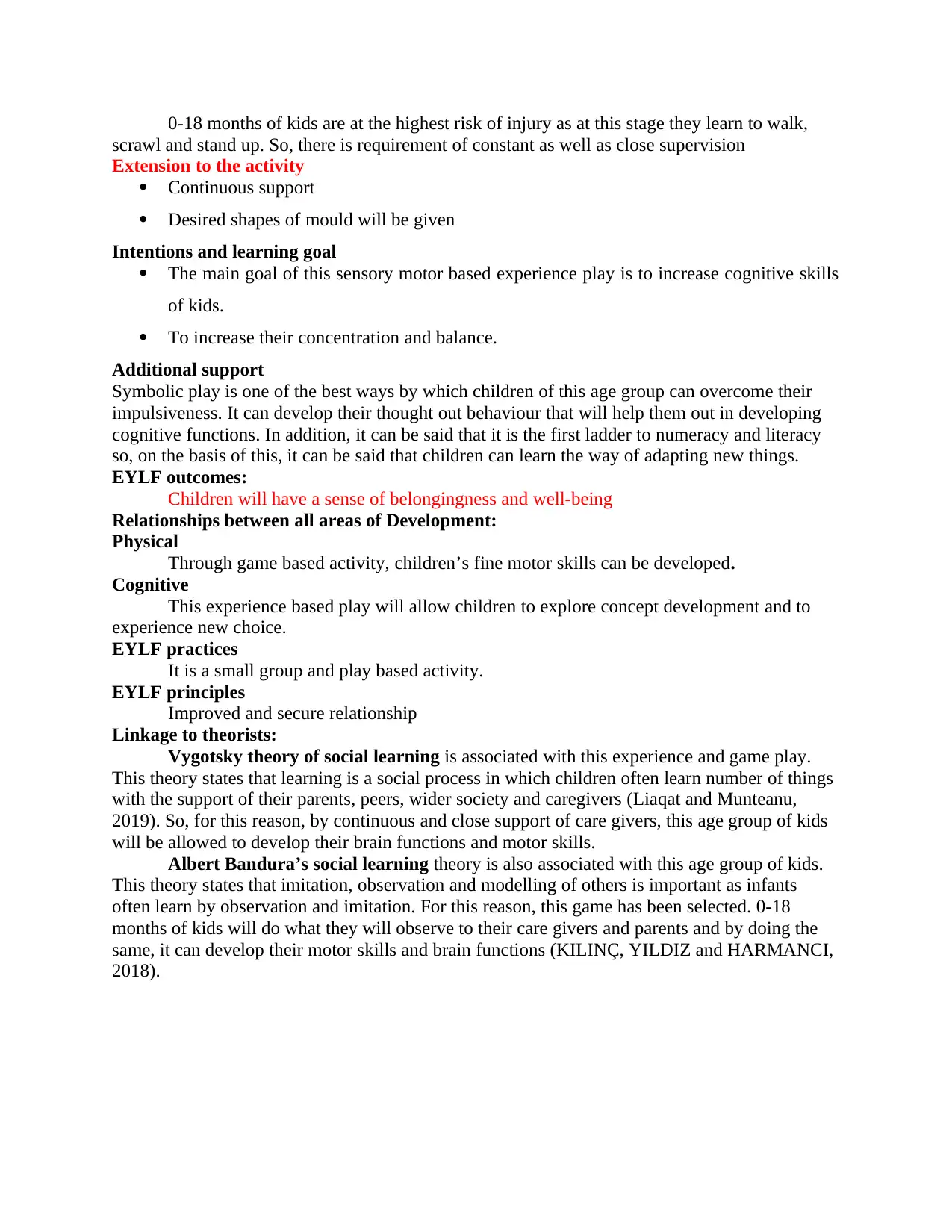
0-18 months of kids are at the highest risk of injury as at this stage they learn to walk,
scrawl and stand up. So, there is requirement of constant as well as close supervision
Extension to the activity
Continuous support
Desired shapes of mould will be given
Intentions and learning goal
The main goal of this sensory motor based experience play is to increase cognitive skills
of kids.
To increase their concentration and balance.
Additional support
Symbolic play is one of the best ways by which children of this age group can overcome their
impulsiveness. It can develop their thought out behaviour that will help them out in developing
cognitive functions. In addition, it can be said that it is the first ladder to numeracy and literacy
so, on the basis of this, it can be said that children can learn the way of adapting new things.
EYLF outcomes:
Children will have a sense of belongingness and well-being
Relationships between all areas of Development:
Physical
Through game based activity, children’s fine motor skills can be developed.
Cognitive
This experience based play will allow children to explore concept development and to
experience new choice.
EYLF practices
It is a small group and play based activity.
EYLF principles
Improved and secure relationship
Linkage to theorists:
Vygotsky theory of social learning is associated with this experience and game play.
This theory states that learning is a social process in which children often learn number of things
with the support of their parents, peers, wider society and caregivers (Liaqat and Munteanu,
2019). So, for this reason, by continuous and close support of care givers, this age group of kids
will be allowed to develop their brain functions and motor skills.
Albert Bandura’s social learning theory is also associated with this age group of kids.
This theory states that imitation, observation and modelling of others is important as infants
often learn by observation and imitation. For this reason, this game has been selected. 0-18
months of kids will do what they will observe to their care givers and parents and by doing the
same, it can develop their motor skills and brain functions (KILINÇ, YILDIZ and HARMANCI,
2018).
scrawl and stand up. So, there is requirement of constant as well as close supervision
Extension to the activity
Continuous support
Desired shapes of mould will be given
Intentions and learning goal
The main goal of this sensory motor based experience play is to increase cognitive skills
of kids.
To increase their concentration and balance.
Additional support
Symbolic play is one of the best ways by which children of this age group can overcome their
impulsiveness. It can develop their thought out behaviour that will help them out in developing
cognitive functions. In addition, it can be said that it is the first ladder to numeracy and literacy
so, on the basis of this, it can be said that children can learn the way of adapting new things.
EYLF outcomes:
Children will have a sense of belongingness and well-being
Relationships between all areas of Development:
Physical
Through game based activity, children’s fine motor skills can be developed.
Cognitive
This experience based play will allow children to explore concept development and to
experience new choice.
EYLF practices
It is a small group and play based activity.
EYLF principles
Improved and secure relationship
Linkage to theorists:
Vygotsky theory of social learning is associated with this experience and game play.
This theory states that learning is a social process in which children often learn number of things
with the support of their parents, peers, wider society and caregivers (Liaqat and Munteanu,
2019). So, for this reason, by continuous and close support of care givers, this age group of kids
will be allowed to develop their brain functions and motor skills.
Albert Bandura’s social learning theory is also associated with this age group of kids.
This theory states that imitation, observation and modelling of others is important as infants
often learn by observation and imitation. For this reason, this game has been selected. 0-18
months of kids will do what they will observe to their care givers and parents and by doing the
same, it can develop their motor skills and brain functions (KILINÇ, YILDIZ and HARMANCI,
2018).
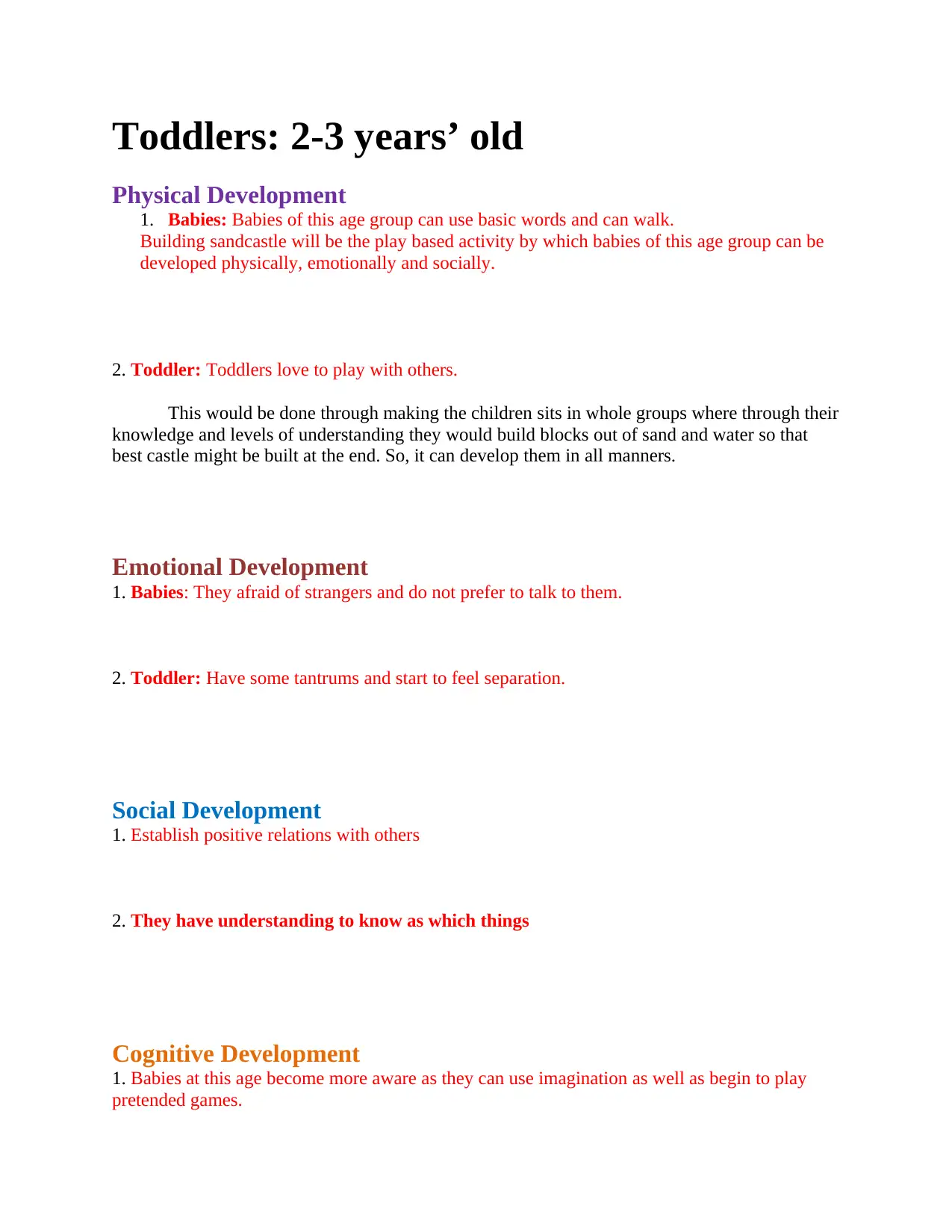
Toddlers: 2-3 years’ old
Physical Development
1. Babies: Babies of this age group can use basic words and can walk.
Building sandcastle will be the play based activity by which babies of this age group can be
developed physically, emotionally and socially.
2. Toddler: Toddlers love to play with others.
This would be done through making the children sits in whole groups where through their
knowledge and levels of understanding they would build blocks out of sand and water so that
best castle might be built at the end. So, it can develop them in all manners.
Emotional Development
1. Babies: They afraid of strangers and do not prefer to talk to them.
2. Toddler: Have some tantrums and start to feel separation.
Social Development
1. Establish positive relations with others
2. They have understanding to know as which things
Cognitive Development
1. Babies at this age become more aware as they can use imagination as well as begin to play
pretended games.
Physical Development
1. Babies: Babies of this age group can use basic words and can walk.
Building sandcastle will be the play based activity by which babies of this age group can be
developed physically, emotionally and socially.
2. Toddler: Toddlers love to play with others.
This would be done through making the children sits in whole groups where through their
knowledge and levels of understanding they would build blocks out of sand and water so that
best castle might be built at the end. So, it can develop them in all manners.
Emotional Development
1. Babies: They afraid of strangers and do not prefer to talk to them.
2. Toddler: Have some tantrums and start to feel separation.
Social Development
1. Establish positive relations with others
2. They have understanding to know as which things
Cognitive Development
1. Babies at this age become more aware as they can use imagination as well as begin to play
pretended games.
Secure Best Marks with AI Grader
Need help grading? Try our AI Grader for instant feedback on your assignments.
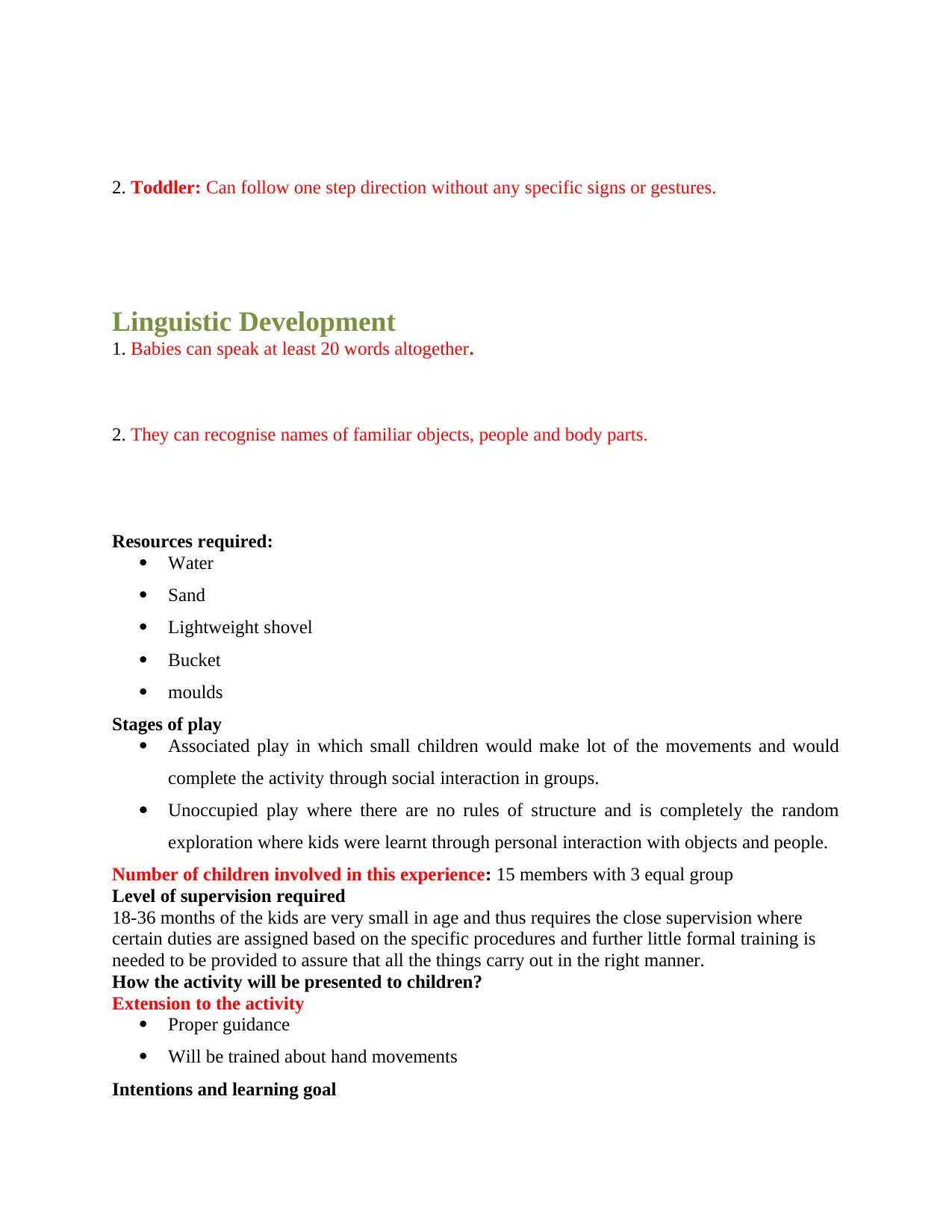
2. Toddler: Can follow one step direction without any specific signs or gestures.
Linguistic Development
1. Babies can speak at least 20 words altogether.
2. They can recognise names of familiar objects, people and body parts.
Resources required:
Water
Sand
Lightweight shovel
Bucket
moulds
Stages of play
Associated play in which small children would make lot of the movements and would
complete the activity through social interaction in groups.
Unoccupied play where there are no rules of structure and is completely the random
exploration where kids were learnt through personal interaction with objects and people.
Number of children involved in this experience: 15 members with 3 equal group
Level of supervision required
18-36 months of the kids are very small in age and thus requires the close supervision where
certain duties are assigned based on the specific procedures and further little formal training is
needed to be provided to assure that all the things carry out in the right manner.
How the activity will be presented to children?
Extension to the activity
Proper guidance
Will be trained about hand movements
Intentions and learning goal
Linguistic Development
1. Babies can speak at least 20 words altogether.
2. They can recognise names of familiar objects, people and body parts.
Resources required:
Water
Sand
Lightweight shovel
Bucket
moulds
Stages of play
Associated play in which small children would make lot of the movements and would
complete the activity through social interaction in groups.
Unoccupied play where there are no rules of structure and is completely the random
exploration where kids were learnt through personal interaction with objects and people.
Number of children involved in this experience: 15 members with 3 equal group
Level of supervision required
18-36 months of the kids are very small in age and thus requires the close supervision where
certain duties are assigned based on the specific procedures and further little formal training is
needed to be provided to assure that all the things carry out in the right manner.
How the activity will be presented to children?
Extension to the activity
Proper guidance
Will be trained about hand movements
Intentions and learning goal
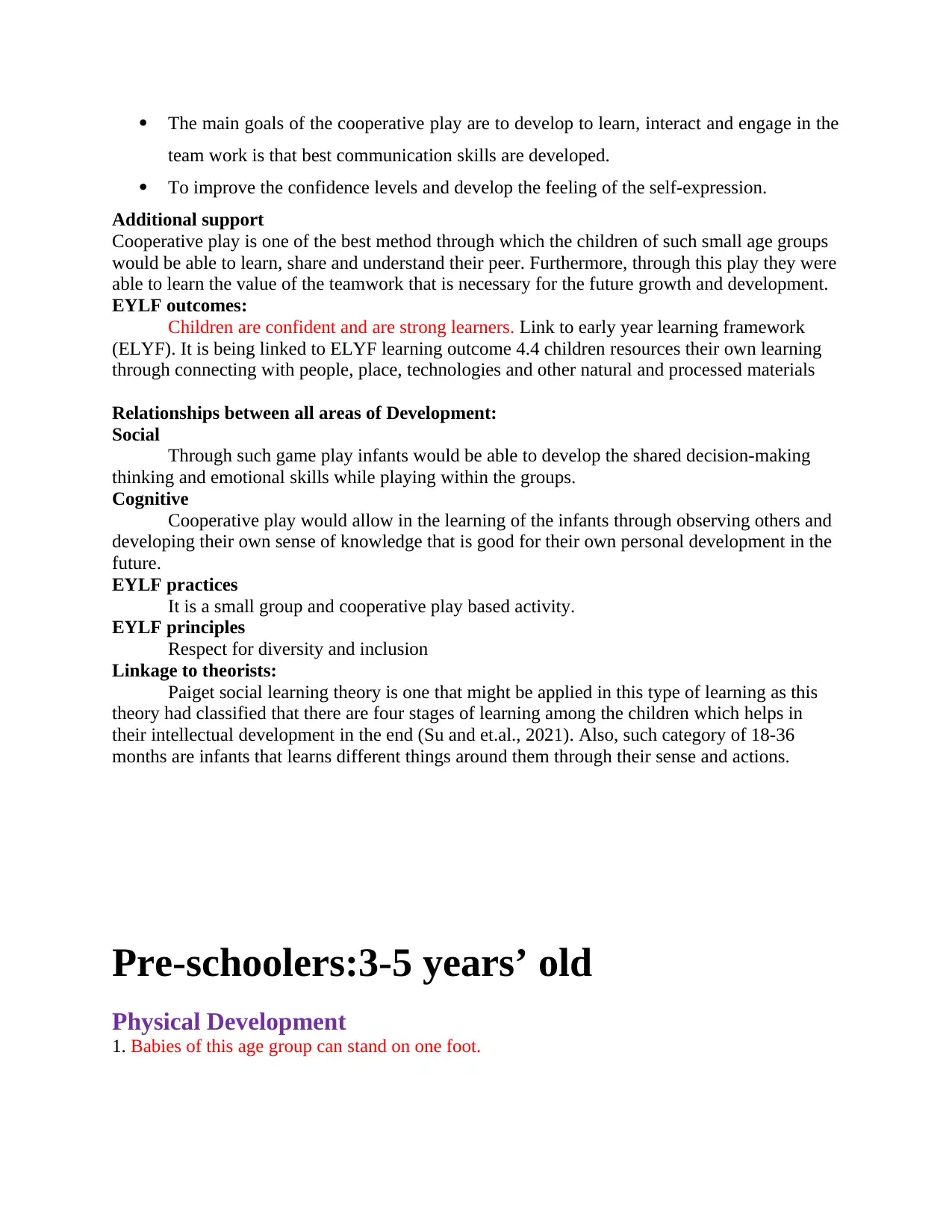
The main goals of the cooperative play are to develop to learn, interact and engage in the
team work is that best communication skills are developed.
To improve the confidence levels and develop the feeling of the self-expression.
Additional support
Cooperative play is one of the best method through which the children of such small age groups
would be able to learn, share and understand their peer. Furthermore, through this play they were
able to learn the value of the teamwork that is necessary for the future growth and development.
EYLF outcomes:
Children are confident and are strong learners. Link to early year learning framework
(ELYF). It is being linked to ELYF learning outcome 4.4 children resources their own learning
through connecting with people, place, technologies and other natural and processed materials
Relationships between all areas of Development:
Social
Through such game play infants would be able to develop the shared decision-making
thinking and emotional skills while playing within the groups.
Cognitive
Cooperative play would allow in the learning of the infants through observing others and
developing their own sense of knowledge that is good for their own personal development in the
future.
EYLF practices
It is a small group and cooperative play based activity.
EYLF principles
Respect for diversity and inclusion
Linkage to theorists:
Paiget social learning theory is one that might be applied in this type of learning as this
theory had classified that there are four stages of learning among the children which helps in
their intellectual development in the end (Su and et.al., 2021). Also, such category of 18-36
months are infants that learns different things around them through their sense and actions.
Pre-schoolers:3-5 years’ old
Physical Development
1. Babies of this age group can stand on one foot.
team work is that best communication skills are developed.
To improve the confidence levels and develop the feeling of the self-expression.
Additional support
Cooperative play is one of the best method through which the children of such small age groups
would be able to learn, share and understand their peer. Furthermore, through this play they were
able to learn the value of the teamwork that is necessary for the future growth and development.
EYLF outcomes:
Children are confident and are strong learners. Link to early year learning framework
(ELYF). It is being linked to ELYF learning outcome 4.4 children resources their own learning
through connecting with people, place, technologies and other natural and processed materials
Relationships between all areas of Development:
Social
Through such game play infants would be able to develop the shared decision-making
thinking and emotional skills while playing within the groups.
Cognitive
Cooperative play would allow in the learning of the infants through observing others and
developing their own sense of knowledge that is good for their own personal development in the
future.
EYLF practices
It is a small group and cooperative play based activity.
EYLF principles
Respect for diversity and inclusion
Linkage to theorists:
Paiget social learning theory is one that might be applied in this type of learning as this
theory had classified that there are four stages of learning among the children which helps in
their intellectual development in the end (Su and et.al., 2021). Also, such category of 18-36
months are infants that learns different things around them through their sense and actions.
Pre-schoolers:3-5 years’ old
Physical Development
1. Babies of this age group can stand on one foot.
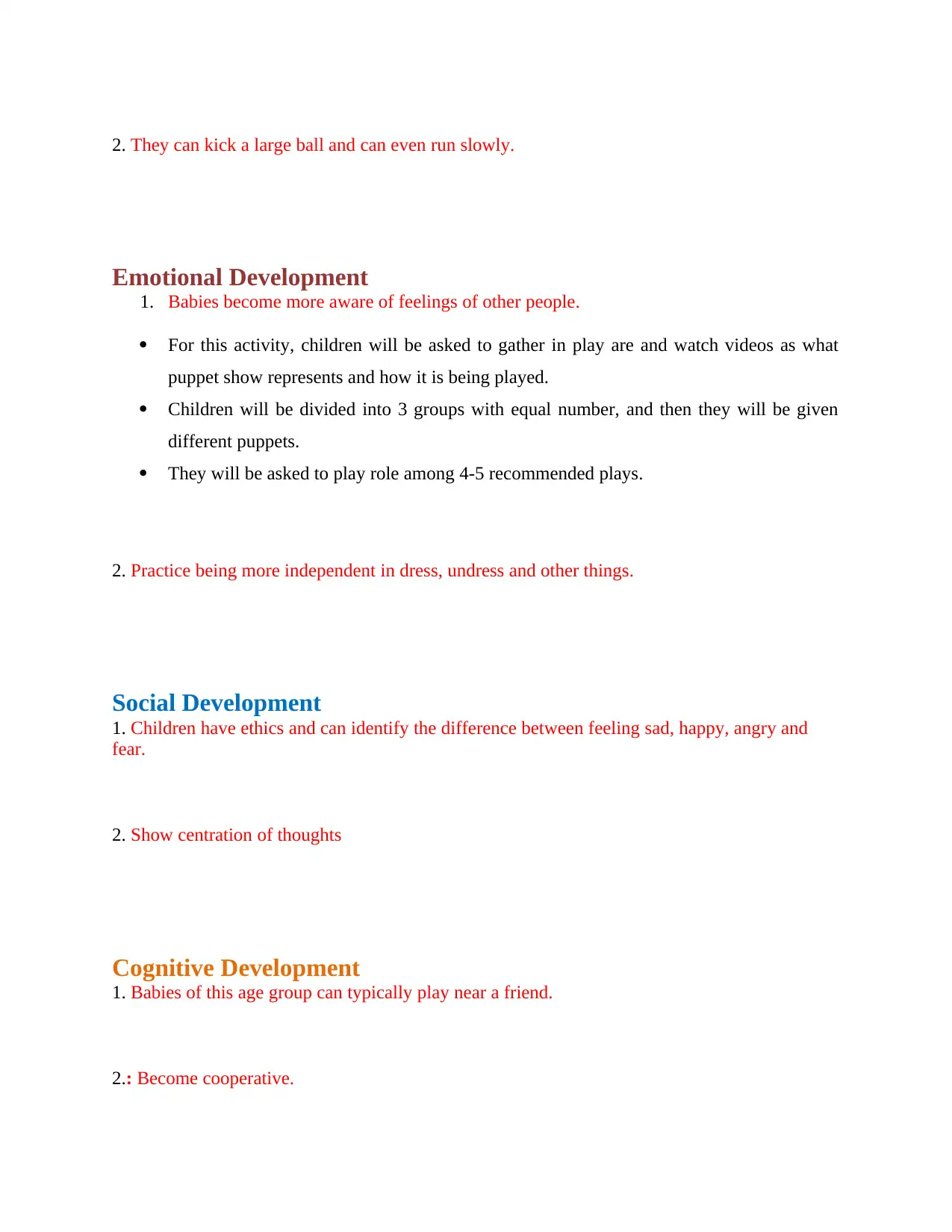
2. They can kick a large ball and can even run slowly.
Emotional Development
1. Babies become more aware of feelings of other people.
For this activity, children will be asked to gather in play are and watch videos as what
puppet show represents and how it is being played.
Children will be divided into 3 groups with equal number, and then they will be given
different puppets.
They will be asked to play role among 4-5 recommended plays.
2. Practice being more independent in dress, undress and other things.
Social Development
1. Children have ethics and can identify the difference between feeling sad, happy, angry and
fear.
2. Show centration of thoughts
Cognitive Development
1. Babies of this age group can typically play near a friend.
2.: Become cooperative.
Emotional Development
1. Babies become more aware of feelings of other people.
For this activity, children will be asked to gather in play are and watch videos as what
puppet show represents and how it is being played.
Children will be divided into 3 groups with equal number, and then they will be given
different puppets.
They will be asked to play role among 4-5 recommended plays.
2. Practice being more independent in dress, undress and other things.
Social Development
1. Children have ethics and can identify the difference between feeling sad, happy, angry and
fear.
2. Show centration of thoughts
Cognitive Development
1. Babies of this age group can typically play near a friend.
2.: Become cooperative.
Paraphrase This Document
Need a fresh take? Get an instant paraphrase of this document with our AI Paraphraser
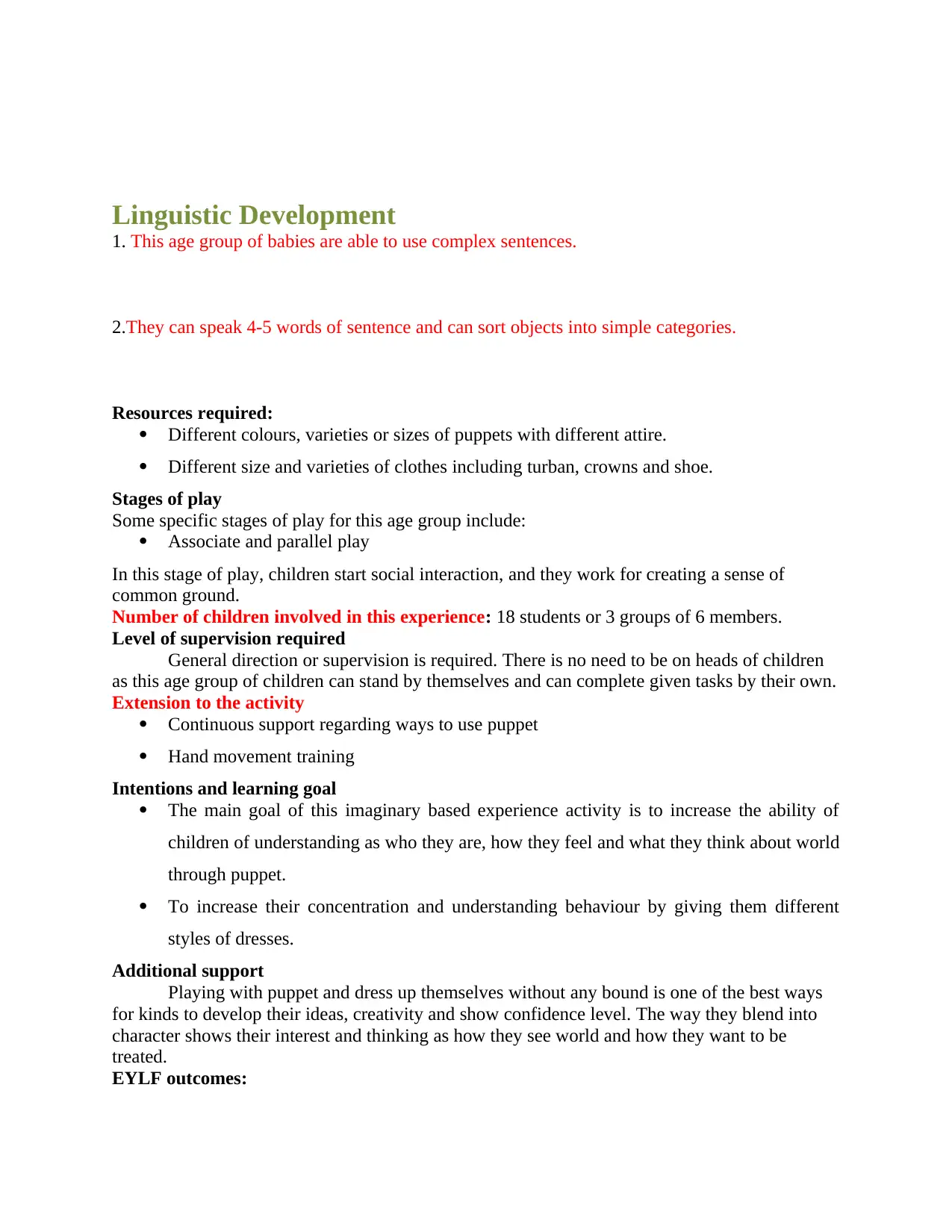
Linguistic Development
1. This age group of babies are able to use complex sentences.
2.They can speak 4-5 words of sentence and can sort objects into simple categories.
Resources required:
Different colours, varieties or sizes of puppets with different attire.
Different size and varieties of clothes including turban, crowns and shoe.
Stages of play
Some specific stages of play for this age group include:
Associate and parallel play
In this stage of play, children start social interaction, and they work for creating a sense of
common ground.
Number of children involved in this experience: 18 students or 3 groups of 6 members.
Level of supervision required
General direction or supervision is required. There is no need to be on heads of children
as this age group of children can stand by themselves and can complete given tasks by their own.
Extension to the activity
Continuous support regarding ways to use puppet
Hand movement training
Intentions and learning goal
The main goal of this imaginary based experience activity is to increase the ability of
children of understanding as who they are, how they feel and what they think about world
through puppet.
To increase their concentration and understanding behaviour by giving them different
styles of dresses.
Additional support
Playing with puppet and dress up themselves without any bound is one of the best ways
for kinds to develop their ideas, creativity and show confidence level. The way they blend into
character shows their interest and thinking as how they see world and how they want to be
treated.
EYLF outcomes:
1. This age group of babies are able to use complex sentences.
2.They can speak 4-5 words of sentence and can sort objects into simple categories.
Resources required:
Different colours, varieties or sizes of puppets with different attire.
Different size and varieties of clothes including turban, crowns and shoe.
Stages of play
Some specific stages of play for this age group include:
Associate and parallel play
In this stage of play, children start social interaction, and they work for creating a sense of
common ground.
Number of children involved in this experience: 18 students or 3 groups of 6 members.
Level of supervision required
General direction or supervision is required. There is no need to be on heads of children
as this age group of children can stand by themselves and can complete given tasks by their own.
Extension to the activity
Continuous support regarding ways to use puppet
Hand movement training
Intentions and learning goal
The main goal of this imaginary based experience activity is to increase the ability of
children of understanding as who they are, how they feel and what they think about world
through puppet.
To increase their concentration and understanding behaviour by giving them different
styles of dresses.
Additional support
Playing with puppet and dress up themselves without any bound is one of the best ways
for kinds to develop their ideas, creativity and show confidence level. The way they blend into
character shows their interest and thinking as how they see world and how they want to be
treated.
EYLF outcomes:
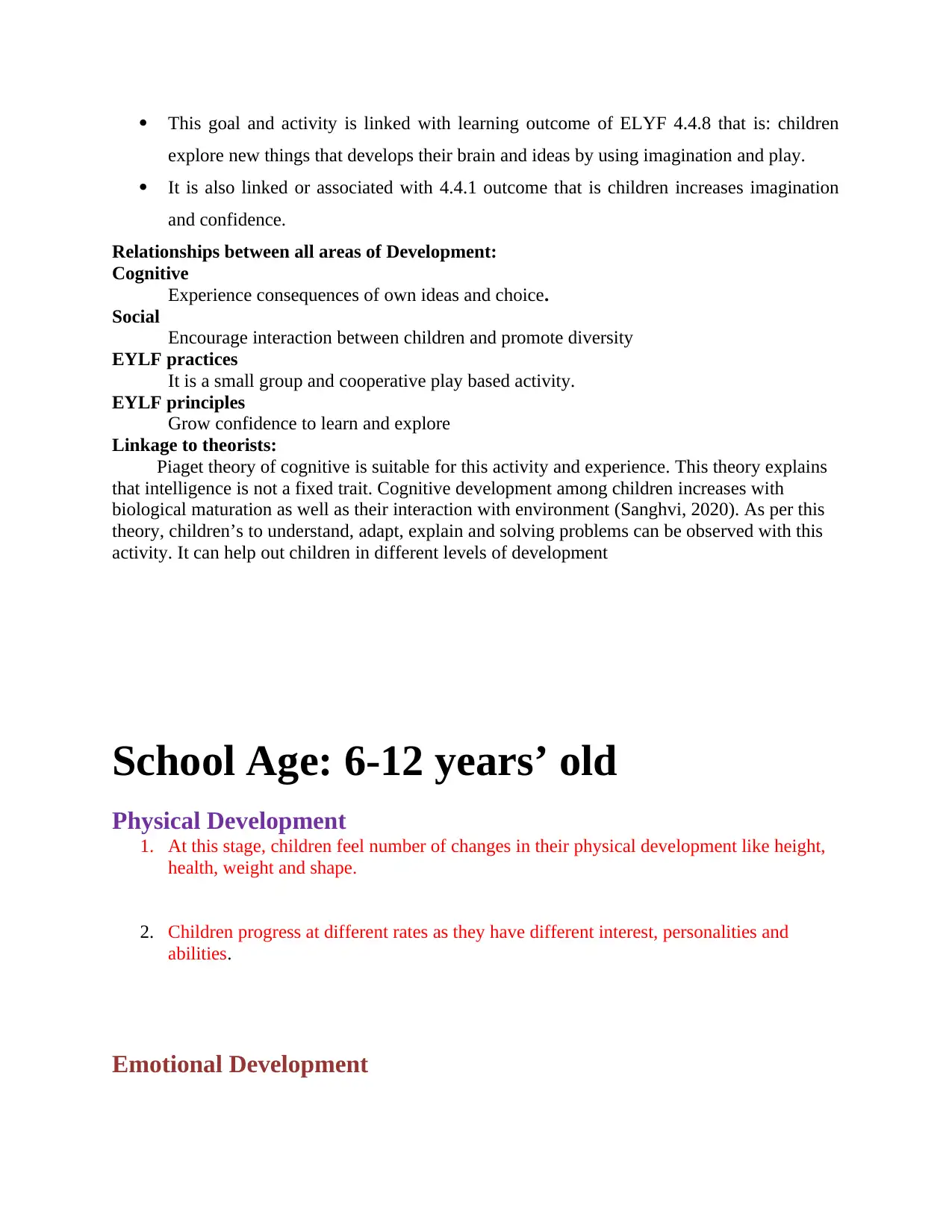
This goal and activity is linked with learning outcome of ELYF 4.4.8 that is: children
explore new things that develops their brain and ideas by using imagination and play.
It is also linked or associated with 4.4.1 outcome that is children increases imagination
and confidence.
Relationships between all areas of Development:
Cognitive
Experience consequences of own ideas and choice.
Social
Encourage interaction between children and promote diversity
EYLF practices
It is a small group and cooperative play based activity.
EYLF principles
Grow confidence to learn and explore
Linkage to theorists:
Piaget theory of cognitive is suitable for this activity and experience. This theory explains
that intelligence is not a fixed trait. Cognitive development among children increases with
biological maturation as well as their interaction with environment (Sanghvi, 2020). As per this
theory, children’s to understand, adapt, explain and solving problems can be observed with this
activity. It can help out children in different levels of development
School Age: 6-12 years’ old
Physical Development
1. At this stage, children feel number of changes in their physical development like height,
health, weight and shape.
2. Children progress at different rates as they have different interest, personalities and
abilities.
Emotional Development
explore new things that develops their brain and ideas by using imagination and play.
It is also linked or associated with 4.4.1 outcome that is children increases imagination
and confidence.
Relationships between all areas of Development:
Cognitive
Experience consequences of own ideas and choice.
Social
Encourage interaction between children and promote diversity
EYLF practices
It is a small group and cooperative play based activity.
EYLF principles
Grow confidence to learn and explore
Linkage to theorists:
Piaget theory of cognitive is suitable for this activity and experience. This theory explains
that intelligence is not a fixed trait. Cognitive development among children increases with
biological maturation as well as their interaction with environment (Sanghvi, 2020). As per this
theory, children’s to understand, adapt, explain and solving problems can be observed with this
activity. It can help out children in different levels of development
School Age: 6-12 years’ old
Physical Development
1. At this stage, children feel number of changes in their physical development like height,
health, weight and shape.
2. Children progress at different rates as they have different interest, personalities and
abilities.
Emotional Development

1. Children of this age group start valuing their friendship and they give importance to
friendship more than blood relations.
2. Develop empathy and control impulsive behaviour.
Under this independent activity child would be asked to throw the object in the small squares that
are numbered from 1 to 9. Also, when the object is dropped at right number than they have to
jump to reach to the object but with only one leg and other being folded
Social Development
1.Children of 6-12 years start learning to cooperate in group setting and group games.
3. Develop lasting friendship and start to handle peer pressure.
Cognitive Development
1. Children of this age group think in real ways but sometimes they feel pressure and
become frustrated easily.
2. At this age, they start feeling differently from others as they begin developing more mature
ways of understanding.
Linguistic Development
1. Children can use different big sentences types and they can easily share their feelings.
2. Start to show fast growth in mental ability.
Resources required:
playground
Small object
chalk
friendship more than blood relations.
2. Develop empathy and control impulsive behaviour.
Under this independent activity child would be asked to throw the object in the small squares that
are numbered from 1 to 9. Also, when the object is dropped at right number than they have to
jump to reach to the object but with only one leg and other being folded
Social Development
1.Children of 6-12 years start learning to cooperate in group setting and group games.
3. Develop lasting friendship and start to handle peer pressure.
Cognitive Development
1. Children of this age group think in real ways but sometimes they feel pressure and
become frustrated easily.
2. At this age, they start feeling differently from others as they begin developing more mature
ways of understanding.
Linguistic Development
1. Children can use different big sentences types and they can easily share their feelings.
2. Start to show fast growth in mental ability.
Resources required:
playground
Small object
chalk
Secure Best Marks with AI Grader
Need help grading? Try our AI Grader for instant feedback on your assignments.
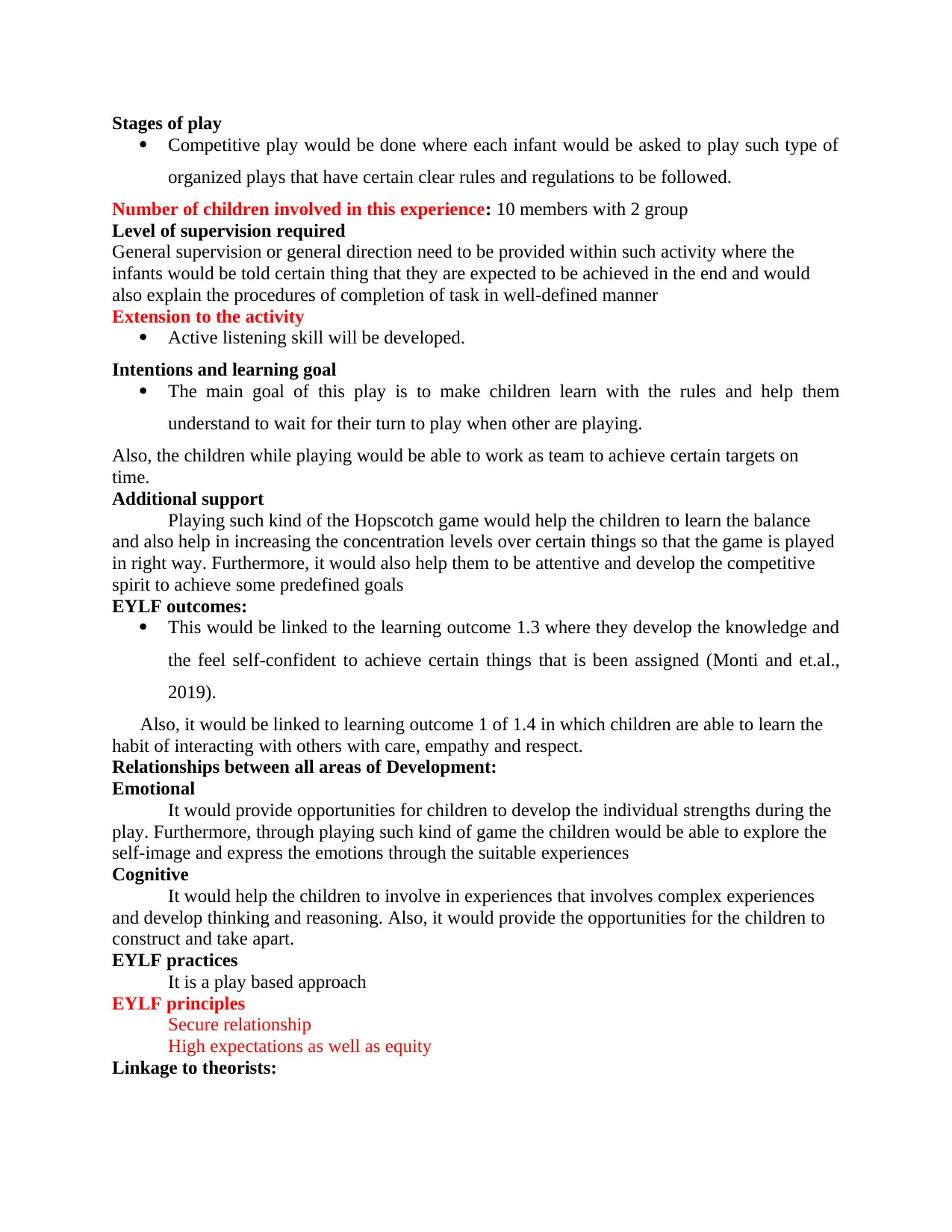
Stages of play
Competitive play would be done where each infant would be asked to play such type of
organized plays that have certain clear rules and regulations to be followed.
Number of children involved in this experience: 10 members with 2 group
Level of supervision required
General supervision or general direction need to be provided within such activity where the
infants would be told certain thing that they are expected to be achieved in the end and would
also explain the procedures of completion of task in well-defined manner
Extension to the activity
Active listening skill will be developed.
Intentions and learning goal
The main goal of this play is to make children learn with the rules and help them
understand to wait for their turn to play when other are playing.
Also, the children while playing would be able to work as team to achieve certain targets on
time.
Additional support
Playing such kind of the Hopscotch game would help the children to learn the balance
and also help in increasing the concentration levels over certain things so that the game is played
in right way. Furthermore, it would also help them to be attentive and develop the competitive
spirit to achieve some predefined goals
EYLF outcomes:
This would be linked to the learning outcome 1.3 where they develop the knowledge and
the feel self-confident to achieve certain things that is been assigned (Monti and et.al.,
2019).
Also, it would be linked to learning outcome 1 of 1.4 in which children are able to learn the
habit of interacting with others with care, empathy and respect.
Relationships between all areas of Development:
Emotional
It would provide opportunities for children to develop the individual strengths during the
play. Furthermore, through playing such kind of game the children would be able to explore the
self-image and express the emotions through the suitable experiences
Cognitive
It would help the children to involve in experiences that involves complex experiences
and develop thinking and reasoning. Also, it would provide the opportunities for the children to
construct and take apart.
EYLF practices
It is a play based approach
EYLF principles
Secure relationship
High expectations as well as equity
Linkage to theorists:
Competitive play would be done where each infant would be asked to play such type of
organized plays that have certain clear rules and regulations to be followed.
Number of children involved in this experience: 10 members with 2 group
Level of supervision required
General supervision or general direction need to be provided within such activity where the
infants would be told certain thing that they are expected to be achieved in the end and would
also explain the procedures of completion of task in well-defined manner
Extension to the activity
Active listening skill will be developed.
Intentions and learning goal
The main goal of this play is to make children learn with the rules and help them
understand to wait for their turn to play when other are playing.
Also, the children while playing would be able to work as team to achieve certain targets on
time.
Additional support
Playing such kind of the Hopscotch game would help the children to learn the balance
and also help in increasing the concentration levels over certain things so that the game is played
in right way. Furthermore, it would also help them to be attentive and develop the competitive
spirit to achieve some predefined goals
EYLF outcomes:
This would be linked to the learning outcome 1.3 where they develop the knowledge and
the feel self-confident to achieve certain things that is been assigned (Monti and et.al.,
2019).
Also, it would be linked to learning outcome 1 of 1.4 in which children are able to learn the
habit of interacting with others with care, empathy and respect.
Relationships between all areas of Development:
Emotional
It would provide opportunities for children to develop the individual strengths during the
play. Furthermore, through playing such kind of game the children would be able to explore the
self-image and express the emotions through the suitable experiences
Cognitive
It would help the children to involve in experiences that involves complex experiences
and develop thinking and reasoning. Also, it would provide the opportunities for the children to
construct and take apart.
EYLF practices
It is a play based approach
EYLF principles
Secure relationship
High expectations as well as equity
Linkage to theorists:

Here the Jaen Paiget theory of social learning is applied where it states that children are
required the self-regulation within themselves so that they are able to successfully play their own
game and follow certain rules (Wong, Konishi and Kong, 2022).
Lev Vygotsky social learning theory also states that school children are able to develop the
level of understanding when they are ben assigned the role-play and pretend play and thus
children learn faster when they play certain games with rules.
CONCLUSION
It has been summarised from the above study that social, cognitive, physical and language
development are important for infants and children. Through different experience based games
can help out children of different age group, in their physical, cognitive and social development.
This study has shown impact of imaginative and symbolic play based experience on children’s
motor skill and cognitive development.
required the self-regulation within themselves so that they are able to successfully play their own
game and follow certain rules (Wong, Konishi and Kong, 2022).
Lev Vygotsky social learning theory also states that school children are able to develop the
level of understanding when they are ben assigned the role-play and pretend play and thus
children learn faster when they play certain games with rules.
CONCLUSION
It has been summarised from the above study that social, cognitive, physical and language
development are important for infants and children. Through different experience based games
can help out children of different age group, in their physical, cognitive and social development.
This study has shown impact of imaginative and symbolic play based experience on children’s
motor skill and cognitive development.
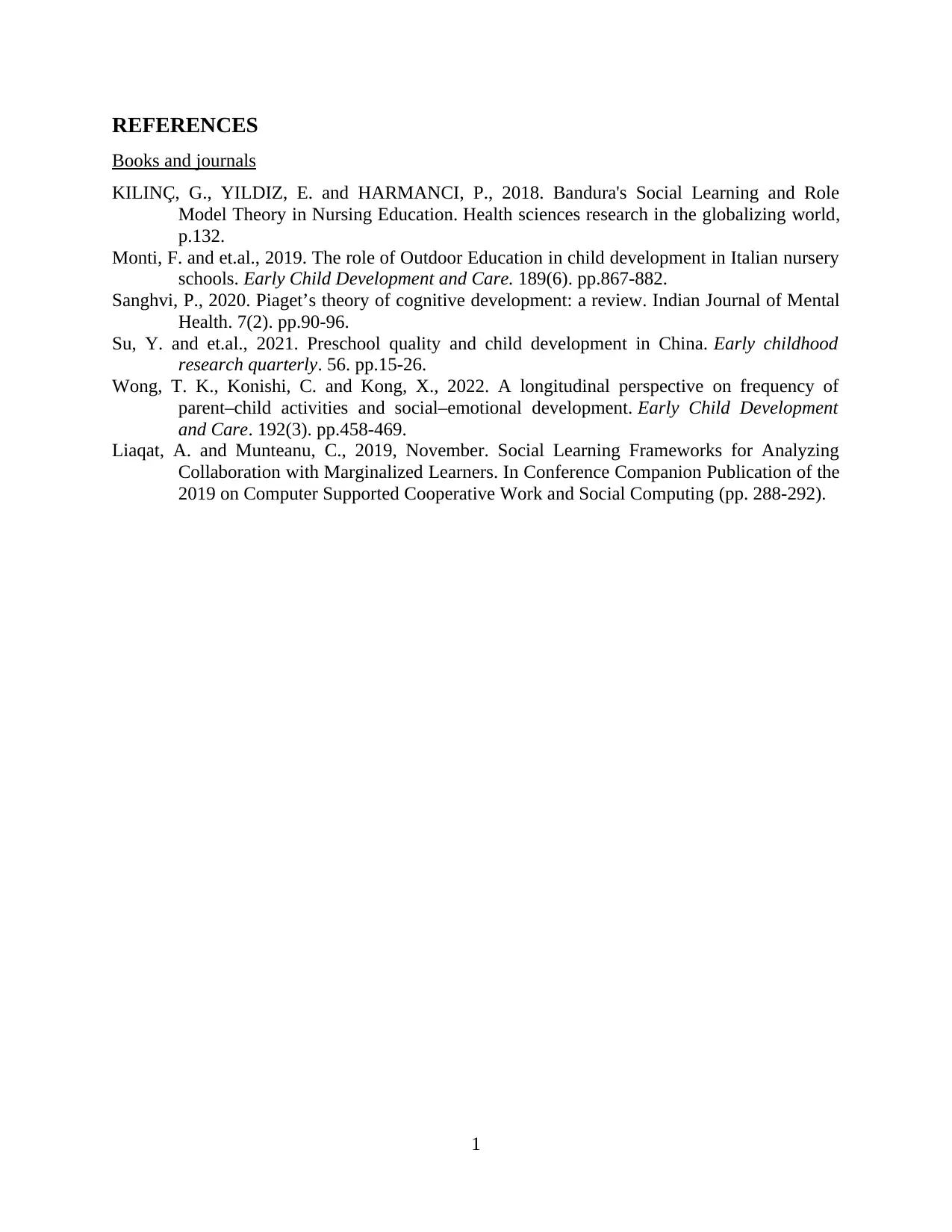
REFERENCES
Books and journals
KILINÇ, G., YILDIZ, E. and HARMANCI, P., 2018. Bandura's Social Learning and Role
Model Theory in Nursing Education. Health sciences research in the globalizing world,
p.132.
Monti, F. and et.al., 2019. The role of Outdoor Education in child development in Italian nursery
schools. Early Child Development and Care. 189(6). pp.867-882.
Sanghvi, P., 2020. Piaget’s theory of cognitive development: a review. Indian Journal of Mental
Health. 7(2). pp.90-96.
Su, Y. and et.al., 2021. Preschool quality and child development in China. Early childhood
research quarterly. 56. pp.15-26.
Wong, T. K., Konishi, C. and Kong, X., 2022. A longitudinal perspective on frequency of
parent–child activities and social–emotional development. Early Child Development
and Care. 192(3). pp.458-469.
Liaqat, A. and Munteanu, C., 2019, November. Social Learning Frameworks for Analyzing
Collaboration with Marginalized Learners. In Conference Companion Publication of the
2019 on Computer Supported Cooperative Work and Social Computing (pp. 288-292).
1
Books and journals
KILINÇ, G., YILDIZ, E. and HARMANCI, P., 2018. Bandura's Social Learning and Role
Model Theory in Nursing Education. Health sciences research in the globalizing world,
p.132.
Monti, F. and et.al., 2019. The role of Outdoor Education in child development in Italian nursery
schools. Early Child Development and Care. 189(6). pp.867-882.
Sanghvi, P., 2020. Piaget’s theory of cognitive development: a review. Indian Journal of Mental
Health. 7(2). pp.90-96.
Su, Y. and et.al., 2021. Preschool quality and child development in China. Early childhood
research quarterly. 56. pp.15-26.
Wong, T. K., Konishi, C. and Kong, X., 2022. A longitudinal perspective on frequency of
parent–child activities and social–emotional development. Early Child Development
and Care. 192(3). pp.458-469.
Liaqat, A. and Munteanu, C., 2019, November. Social Learning Frameworks for Analyzing
Collaboration with Marginalized Learners. In Conference Companion Publication of the
2019 on Computer Supported Cooperative Work and Social Computing (pp. 288-292).
1
1 out of 13
Related Documents
Your All-in-One AI-Powered Toolkit for Academic Success.
+13062052269
info@desklib.com
Available 24*7 on WhatsApp / Email
![[object Object]](/_next/static/media/star-bottom.7253800d.svg)
Unlock your academic potential
© 2024 | Zucol Services PVT LTD | All rights reserved.





